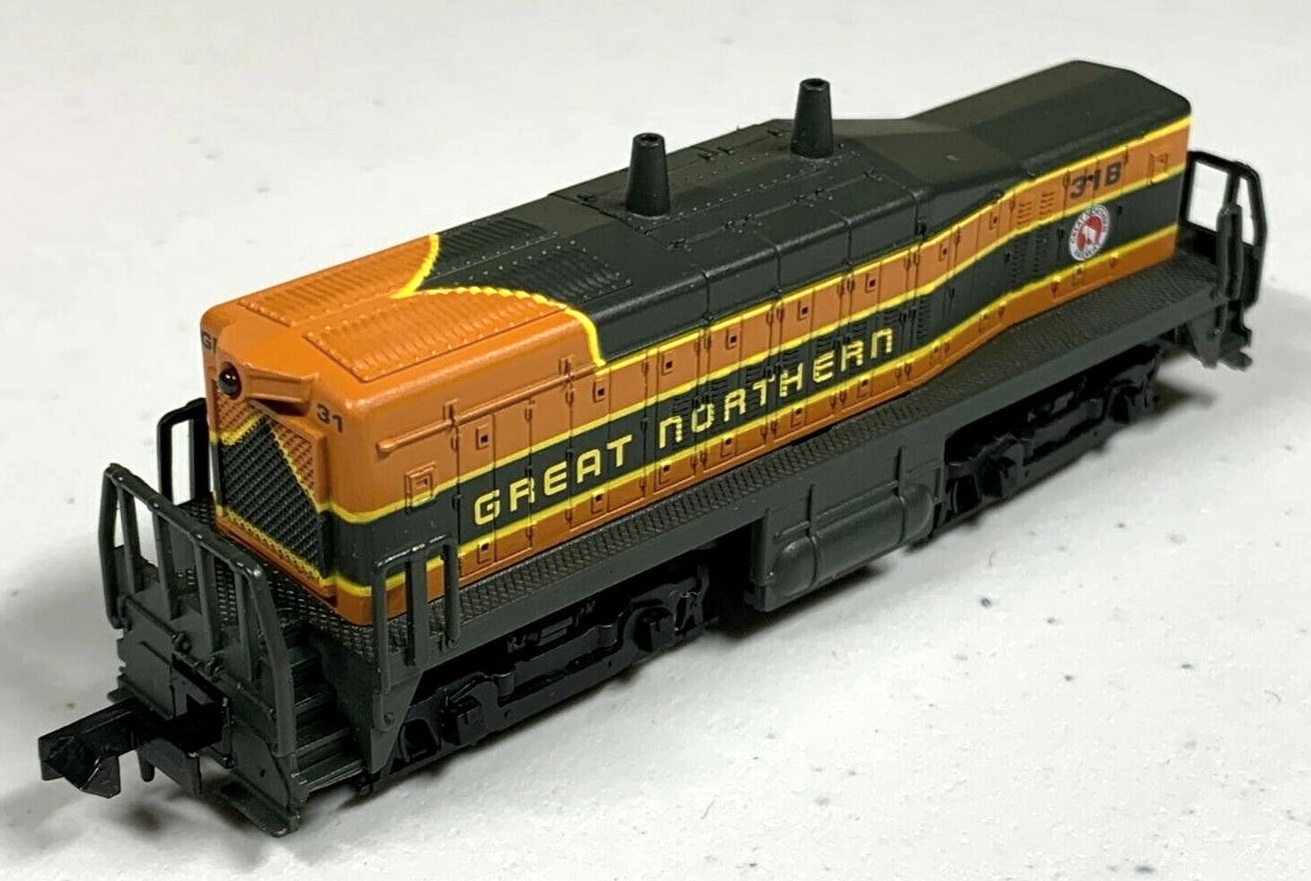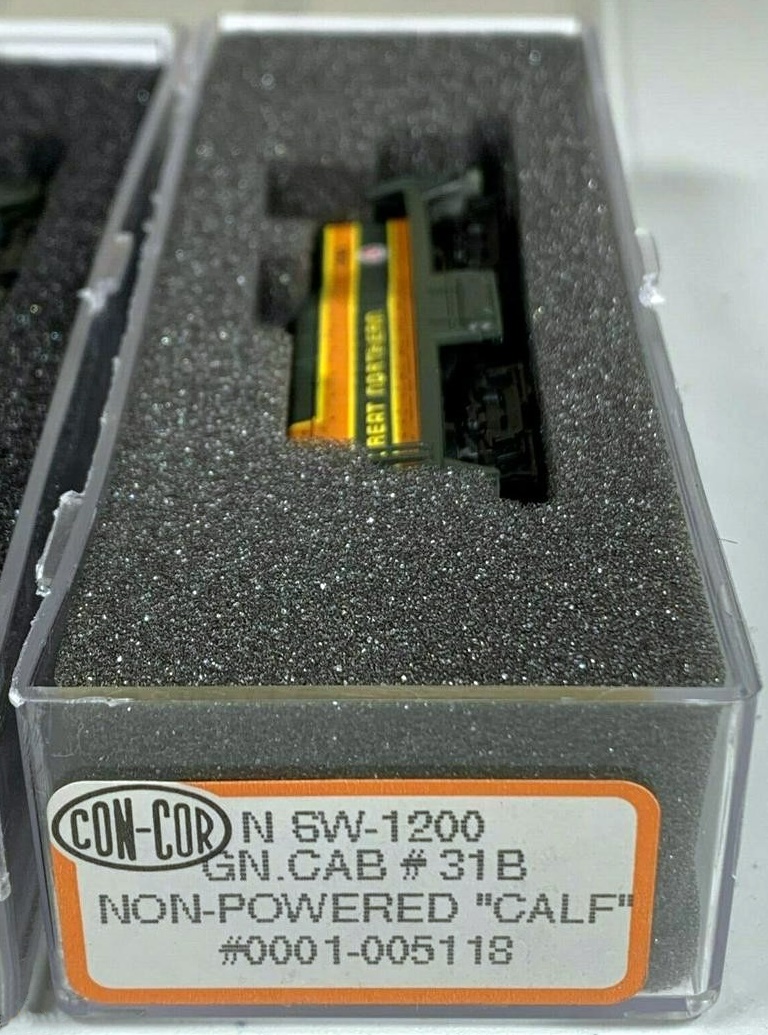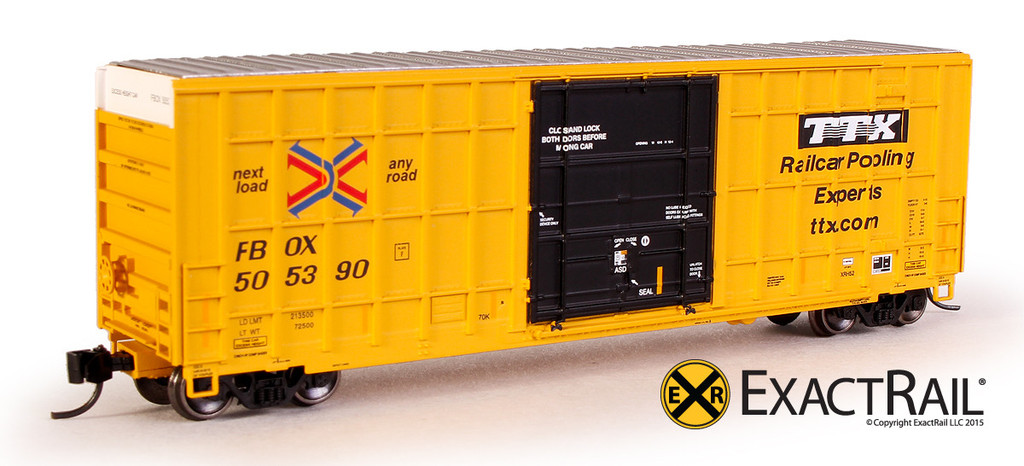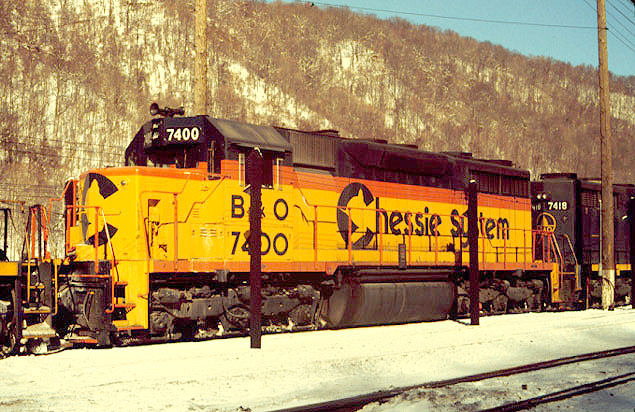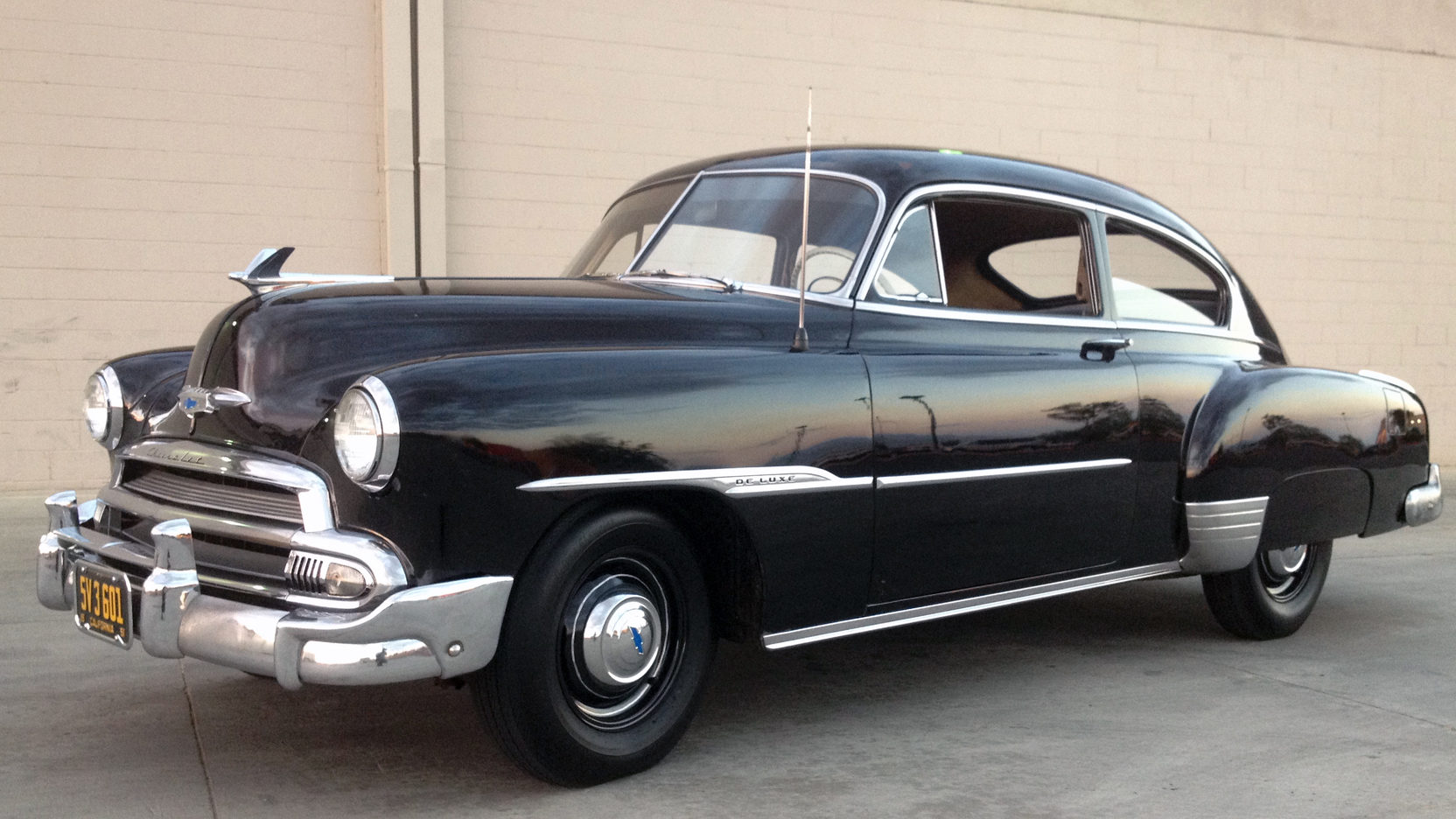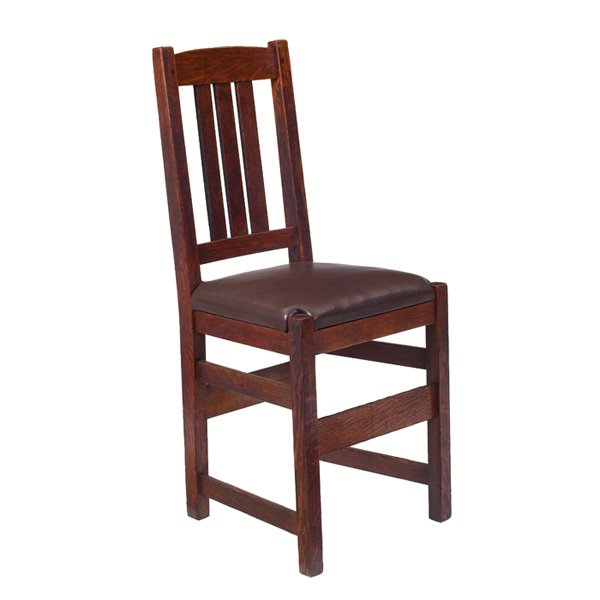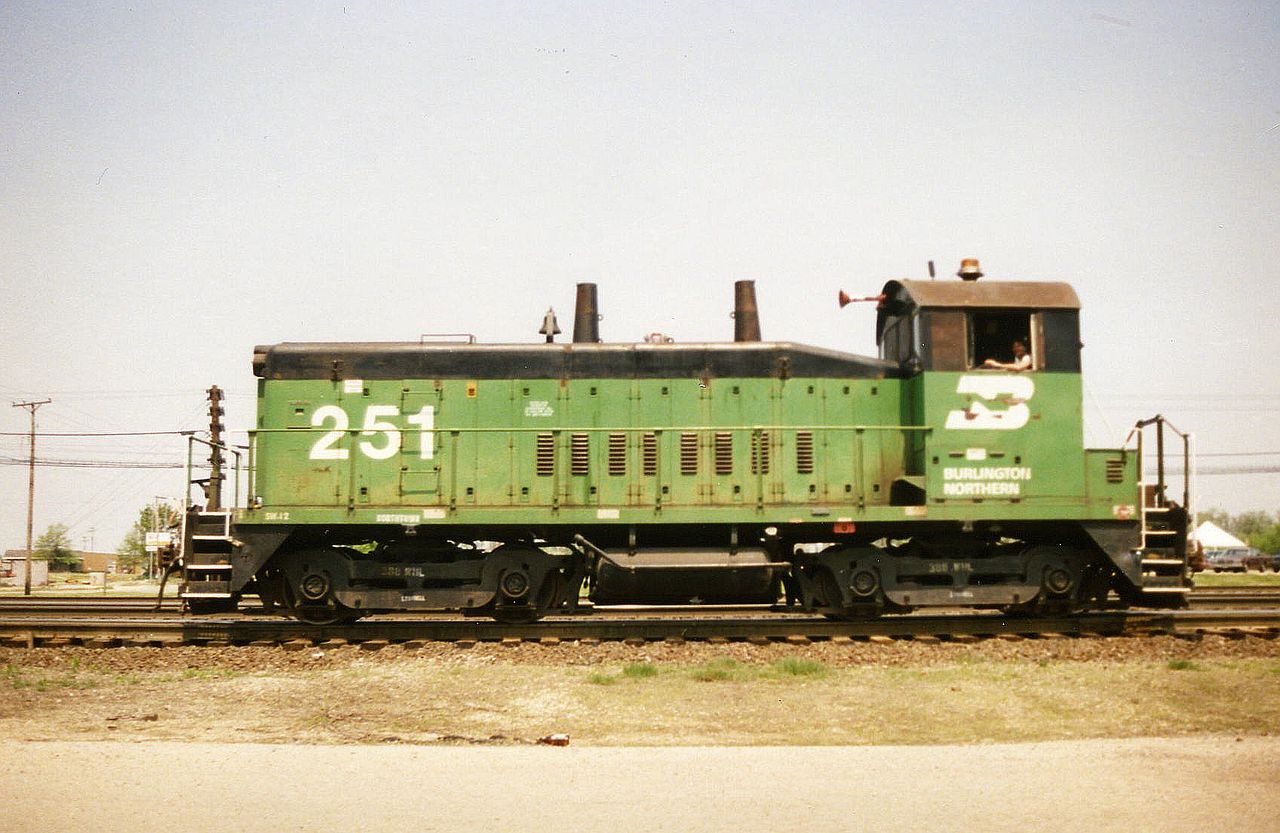Model Information: This body style is for the Con-Cor versions with Rivarossi, Kato or Con-Cor mechanisms.
This model was first produced by Rivarossi for Atlas in 1971. The trucks are marked 'Made in Italy' with a Rivarossi logo and an Atlas logo. The motor is visible from below on the powered cow. On the dummy calf, a large hollow can be seen from the bottom of the model, corresponding to the missing motor.
After Atlas stopped ordering them ca. 1977, Rivarossi continued selling them with its own brand and reference (#91xx) and released one additional paint scheme (SP Black Widow) in 1980. Con-Cor also began importing the Rivarossi model. On this model, the trucks are marked 'Made in Italy' with a Rivarossi logo only.
The Rivarossi/Con-Cor version was available powered or unpowered, for both the cow and the calf. The Con-Cor stock numbers are in the form 5001 or 5002 (powered cow), 5011 or 5012 (unpowered cow), 5021 or 5022 (powered calf), 5031 or 5032 (unpowered calf), followed by a letter assigned for each road name.
The boxes can also be labeled with a Rivarossi stock number on one end and a Con-Cor stock number on the other end, sometimes printed on a Rivarossi label.
Models not in Rivarossi catalog, so only sold by Con-Cor, may still show a Rivarossi stock number, corresponding to the type of chassis - #9288 (dummy calf) or #9289 (dummy cow) or #9290 (powered cow) - on one side and a Con-Cor stock number on the other side. The Con-Cor number was on a sticker which tended to detach with age, leaving only the printed Rivarossi number. Hence many classifieds are using the non-distinctive Rivarossi number 9288 or 9289 or 9890.
At a certain point ca. 1985, apparently dissatisfied with the mechanisms made by Rivarossi, Con-Cor had Kato design a new, more reliable, mechanism but continued use of the Rivarossi shell. This new Kato/Rivarossi hybrid was produced until 1989. The change of mechanism only applied to the 'cow' powered unit; the 'calf' dummy unit continued to be fully made by Rivarossi. On the powered cow, the trucks are marked '17712/Made in Japan' with Kato logo and the fuel tank is marked 'Con-Cor' on the bottom.
In 1996, Arnold/Rivarossi re-released the same model with yet another new mechanism and a few improvements of the shell (thinner handrails and tank details). On this model, the fuel tank is marked 'Arnold/Made in Germany'. The couplers are truck-mounted.
In 1997, Con-Cor released a new version of the model this time using a Chinese manufactured mechanism, but with the shell still more or less the same. These Chinese versions were marketed as SW-1200s. The bottom of the trucks is marked '17712/Made in China', without logo. The 'calf' dummy unit still continued to be fully made by Rivarossi
Con-Cor stopped making their version during the downsizing in 2005 and Arnold stopped producing theirs in 2006 with the bankruptcy.
Adding to the confusion, Con-Cor decided to re-use for the 1997 SW-1200 cow version, the same stock number range that was used for the previous Kato version sets (cow/calf). So any stock number from 0001-005000 to 0001-005023 can refer to one or the other.
The model was designed from early EMD drawings for the SW1500 prototype, that were quite similar to the SW1200 drawings. Eventually the final SW1500 prototype was released with significant changes to the early drawing. So though the model is sold as a SW1500, it is actually closer to a SW1200 than to a SW1500. Moreover, if a cow-calf version of the SW1200 (TR12) was offered in the catalog, it was actually never purchased. No cow-calf version of the SW1500 was ever envisaged.
This model was first produced by Rivarossi for Atlas in 1971. The trucks are marked 'Made in Italy' with a Rivarossi logo and an Atlas logo. The motor is visible from below on the powered cow. On the dummy calf, a large hollow can be seen from the bottom of the model, corresponding to the missing motor.
After Atlas stopped ordering them ca. 1977, Rivarossi continued selling them with its own brand and reference (#91xx) and released one additional paint scheme (SP Black Widow) in 1980. Con-Cor also began importing the Rivarossi model. On this model, the trucks are marked 'Made in Italy' with a Rivarossi logo only.
The Rivarossi/Con-Cor version was available powered or unpowered, for both the cow and the calf. The Con-Cor stock numbers are in the form 5001 or 5002 (powered cow), 5011 or 5012 (unpowered cow), 5021 or 5022 (powered calf), 5031 or 5032 (unpowered calf), followed by a letter assigned for each road name.
The boxes can also be labeled with a Rivarossi stock number on one end and a Con-Cor stock number on the other end, sometimes printed on a Rivarossi label.
Models not in Rivarossi catalog, so only sold by Con-Cor, may still show a Rivarossi stock number, corresponding to the type of chassis - #9288 (dummy calf) or #9289 (dummy cow) or #9290 (powered cow) - on one side and a Con-Cor stock number on the other side. The Con-Cor number was on a sticker which tended to detach with age, leaving only the printed Rivarossi number. Hence many classifieds are using the non-distinctive Rivarossi number 9288 or 9289 or 9890.
At a certain point ca. 1985, apparently dissatisfied with the mechanisms made by Rivarossi, Con-Cor had Kato design a new, more reliable, mechanism but continued use of the Rivarossi shell. This new Kato/Rivarossi hybrid was produced until 1989. The change of mechanism only applied to the 'cow' powered unit; the 'calf' dummy unit continued to be fully made by Rivarossi. On the powered cow, the trucks are marked '17712/Made in Japan' with Kato logo and the fuel tank is marked 'Con-Cor' on the bottom.
In 1996, Arnold/Rivarossi re-released the same model with yet another new mechanism and a few improvements of the shell (thinner handrails and tank details). On this model, the fuel tank is marked 'Arnold/Made in Germany'. The couplers are truck-mounted.
In 1997, Con-Cor released a new version of the model this time using a Chinese manufactured mechanism, but with the shell still more or less the same. These Chinese versions were marketed as SW-1200s. The bottom of the trucks is marked '17712/Made in China', without logo. The 'calf' dummy unit still continued to be fully made by Rivarossi
Con-Cor stopped making their version during the downsizing in 2005 and Arnold stopped producing theirs in 2006 with the bankruptcy.
Adding to the confusion, Con-Cor decided to re-use for the 1997 SW-1200 cow version, the same stock number range that was used for the previous Kato version sets (cow/calf). So any stock number from 0001-005000 to 0001-005023 can refer to one or the other.
The model was designed from early EMD drawings for the SW1500 prototype, that were quite similar to the SW1200 drawings. Eventually the final SW1500 prototype was released with significant changes to the early drawing. So though the model is sold as a SW1500, it is actually closer to a SW1200 than to a SW1500. Moreover, if a cow-calf version of the SW1200 (TR12) was offered in the catalog, it was actually never purchased. No cow-calf version of the SW1500 was ever envisaged.
DCC Information: No provision for DCC, except on the Arnold version.
Prototype History: An EMD SW1200 is a diesel switcher locomotive built by General Motors Electro-Motive Division between January 1954 and May 1966. Power was provided by an EMD 567C 12-cylinder engine which generated 1,200 hp (895 kW). Late SW1200s built in 1966 were built with the 567E 12-cylinder engine. Additional SW1200 production was completed by General Motors Diesel in Ontario Canada between September 1955 and June 1964.
737 examples of this locomotive model were built for American railroads, 287 were built for Canadian railroads 4 were built for Brazilian Railroads, 25 were built for a Chilean Industrial firm, and 3 were built for the Panama Canal Railway. A cow-calf variation, the TR12, was cataloged, but none were built. A few units were built with dynamic brakes, featuring large square box with a fan on top of the hood, right in front of the cab.
An SW1200RS is a variation of the standard SW1200 that featured large front and rear (on some units) numberboard housings, EMD Flexicoil B-B trucks, and larger fuel tanks for roadswitcher service. The majority of the Canadian National and Canadian Pacific SW1200 fleets were purchased as SW1200RS units. The Sandersville Railroad Company EMD SW1200 road number SAN 1200 formerly SAN 200 was originally built with the V-12 EMD 567C Prime Mover but it was replaced with a V-12 EMD 645 Prime Mover, the two both produce 1,200 Horsepower, even though the same motor in the EMD SW1500 produces 1,500 Horsepower. The SAN 1200 also has EMD Flexcoil trucks instead of the standard switcher trucks found on other EMD SW1200s.
From Wikipedia
737 examples of this locomotive model were built for American railroads, 287 were built for Canadian railroads 4 were built for Brazilian Railroads, 25 were built for a Chilean Industrial firm, and 3 were built for the Panama Canal Railway. A cow-calf variation, the TR12, was cataloged, but none were built. A few units were built with dynamic brakes, featuring large square box with a fan on top of the hood, right in front of the cab.
An SW1200RS is a variation of the standard SW1200 that featured large front and rear (on some units) numberboard housings, EMD Flexicoil B-B trucks, and larger fuel tanks for roadswitcher service. The majority of the Canadian National and Canadian Pacific SW1200 fleets were purchased as SW1200RS units. The Sandersville Railroad Company EMD SW1200 road number SAN 1200 formerly SAN 200 was originally built with the V-12 EMD 567C Prime Mover but it was replaced with a V-12 EMD 645 Prime Mover, the two both produce 1,200 Horsepower, even though the same motor in the EMD SW1500 produces 1,500 Horsepower. The SAN 1200 also has EMD Flexcoil trucks instead of the standard switcher trucks found on other EMD SW1200s.
From Wikipedia
Road Name History: The Great Northern was born in 1881 with the consolidation of several railroads of the northern plains under the leadership of James J. Hill. By 1893, the mainline from the Great Lakes and the Mississippi River to Seattle was complete.
The GN had two distinctly different characters. The eastern half was a largely flat, grain producing region serving cities like Fargo, the Twin Cities, Grand Forks, Duluth, Sioux Falls, Sioux City and even Winnipeg in Canada. The east end also included the iron ore rich regions of Minnesota. Half of North Dakota was blanketed by GN branchlines (21 in all) serving every imaginable grain elevator.
The western half is the mountainous portion that most people identify with Great Northern. This included crossing the northern Rockies and the even more difficult Cascade ranges. Cities on the western half included Billings, Butte, Helena, Havre, Spokane, Portland, Seattle, and Vancouver. In 1931, a connection to the Western Pacific was completed from Bieber north to Bend, Oregon. This line was disconnected from the rest of the Great Northern. They used trackage rights on the Oregon Trunk and SP&S to bridge the gap. The Cascade Tunnel, the longest on the continent at 7.8 miles, wasn’t completed until 1931. Construction included a massive sluiceway and hydro-electric power station to feed the electrified line through the tunnel and several miles of railroad on either side. This replaced the original Cascade Tunnel which was a third as long but 500 feet higher up the mountain. That replaced the original route that was another 700 feet higher, had 4% grades and 50 miles of snowsheds. All told, Great Northern had about 8,300 route miles.
The steam era was especially unkind to the Great Northern. They seemed to go out of their way to make their locomotives ugly. Belpaire fire boxes were the norm (made famous by the Pennsylvania, made hideous on the GN.) Headlights were often mounted just above center giving them a spinster look. Cab fronts were often at odd angles. The tender coal bunkers were often taller than the engines. But it wasn’t just aesthetics. GN had a knack for buying the wrong engines for the job. 150 Prarie type 2-6-2’s were so unstable at speed that they were busted down to branchline duty almost straight away and none survived after about 1930. Their first 4-8-2 Mountains built for passenger and fast freight were such a disaster, they were rebuilt into 2-10-2’s. Many railroads had built Mountains out of Mikes but no one had ever started with a Mountain and had to build something else from it. The first 2-6-6-2’s were so under-powered, the boilers were used to make Mikados instead. They did manage to build the largest, fastest, and most powerful Mikados in the country however. Their articulated fleet included 2-6-6-2, 2-6-8-0 (later rebuilt into Mikes), 2-8-8-0, 2-8-8-2 types as well as a pair of Challengers originally delivered to SP&S. Many engines were dressed up with green boilers and boxcar red cab roofs.
For the first generation of diesels, GN bought like many large railroads did: a sampling from everyone. Cab and hood units from EMD and Alco and switchers from EMD, Alco, and Baldwin populated the roster. GN’s first generation geeps and SD’s were delivered with the long hood as the front. This included their GP20’s which had high short hoods and the long hood as the front. Aside from an early black scheme for switchers, the GN fleet was delivered in Omaha Orange and green with yellow piping.
Beginning with the arrival of GP30s in 1962, the paint scheme was simplified by dropping the bottom orange band and the yellow piping. For the second generation, General Electric replaced Alco as a supplier of new road engines.
In 1962, some GN freight cars began to appear in Glacier Green which ran along side the vermilion paint adopted in 1956. In 1967, they went for a major shift. Sky Blue, white, and dark gray were joined by a new version of the Rocky the goat logo. There was talk that this would become the paint scheme for Burlington Northern. The GN name and logo was painted on a steel panel bolted the the hand railings of hood units, making it easier to remove after the merger. For whatever reason, they went with green, black and white, a version of which was simultaneously being tested on the Burlington Route. In 1970, Great Northern, Northern Pacific, Spokane Portland & Seattle, and Burlington Route merged to form Burlington Northern.
The GN had two distinctly different characters. The eastern half was a largely flat, grain producing region serving cities like Fargo, the Twin Cities, Grand Forks, Duluth, Sioux Falls, Sioux City and even Winnipeg in Canada. The east end also included the iron ore rich regions of Minnesota. Half of North Dakota was blanketed by GN branchlines (21 in all) serving every imaginable grain elevator.
The western half is the mountainous portion that most people identify with Great Northern. This included crossing the northern Rockies and the even more difficult Cascade ranges. Cities on the western half included Billings, Butte, Helena, Havre, Spokane, Portland, Seattle, and Vancouver. In 1931, a connection to the Western Pacific was completed from Bieber north to Bend, Oregon. This line was disconnected from the rest of the Great Northern. They used trackage rights on the Oregon Trunk and SP&S to bridge the gap. The Cascade Tunnel, the longest on the continent at 7.8 miles, wasn’t completed until 1931. Construction included a massive sluiceway and hydro-electric power station to feed the electrified line through the tunnel and several miles of railroad on either side. This replaced the original Cascade Tunnel which was a third as long but 500 feet higher up the mountain. That replaced the original route that was another 700 feet higher, had 4% grades and 50 miles of snowsheds. All told, Great Northern had about 8,300 route miles.
The steam era was especially unkind to the Great Northern. They seemed to go out of their way to make their locomotives ugly. Belpaire fire boxes were the norm (made famous by the Pennsylvania, made hideous on the GN.) Headlights were often mounted just above center giving them a spinster look. Cab fronts were often at odd angles. The tender coal bunkers were often taller than the engines. But it wasn’t just aesthetics. GN had a knack for buying the wrong engines for the job. 150 Prarie type 2-6-2’s were so unstable at speed that they were busted down to branchline duty almost straight away and none survived after about 1930. Their first 4-8-2 Mountains built for passenger and fast freight were such a disaster, they were rebuilt into 2-10-2’s. Many railroads had built Mountains out of Mikes but no one had ever started with a Mountain and had to build something else from it. The first 2-6-6-2’s were so under-powered, the boilers were used to make Mikados instead. They did manage to build the largest, fastest, and most powerful Mikados in the country however. Their articulated fleet included 2-6-6-2, 2-6-8-0 (later rebuilt into Mikes), 2-8-8-0, 2-8-8-2 types as well as a pair of Challengers originally delivered to SP&S. Many engines were dressed up with green boilers and boxcar red cab roofs.
For the first generation of diesels, GN bought like many large railroads did: a sampling from everyone. Cab and hood units from EMD and Alco and switchers from EMD, Alco, and Baldwin populated the roster. GN’s first generation geeps and SD’s were delivered with the long hood as the front. This included their GP20’s which had high short hoods and the long hood as the front. Aside from an early black scheme for switchers, the GN fleet was delivered in Omaha Orange and green with yellow piping.
Beginning with the arrival of GP30s in 1962, the paint scheme was simplified by dropping the bottom orange band and the yellow piping. For the second generation, General Electric replaced Alco as a supplier of new road engines.
In 1962, some GN freight cars began to appear in Glacier Green which ran along side the vermilion paint adopted in 1956. In 1967, they went for a major shift. Sky Blue, white, and dark gray were joined by a new version of the Rocky the goat logo. There was talk that this would become the paint scheme for Burlington Northern. The GN name and logo was painted on a steel panel bolted the the hand railings of hood units, making it easier to remove after the merger. For whatever reason, they went with green, black and white, a version of which was simultaneously being tested on the Burlington Route. In 1970, Great Northern, Northern Pacific, Spokane Portland & Seattle, and Burlington Route merged to form Burlington Northern.
Brand/Importer Information: Con-Cor has been in business since 1962. Many things have changed over time as originally they were a complete manufacturing operation in the USA and at one time had upwards of 45 employees. They not only designed the models,but they also built their own molds, did injection molding, painting, printing and packaging on their models.
Currently, most of their manufacturing has been moved overseas and now they import 90% of their products as totally finished goods, or in finished components. They only do some incidental manufacturing today within the USA.
Important Note: The Con-Cor product numbering can be very confusing. Please see here in the article how to properly enter Con-Cor stock numbers in the TroveStar database.
Currently, most of their manufacturing has been moved overseas and now they import 90% of their products as totally finished goods, or in finished components. They only do some incidental manufacturing today within the USA.
Important Note: The Con-Cor product numbering can be very confusing. Please see here in the article how to properly enter Con-Cor stock numbers in the TroveStar database.
Item created by: Alain LM on 2022-01-19 14:58:39
If you see errors or missing data in this entry, please feel free to log in and edit it. Anyone with a Gmail account can log in instantly.
If you see errors or missing data in this entry, please feel free to log in and edit it. Anyone with a Gmail account can log in instantly.


